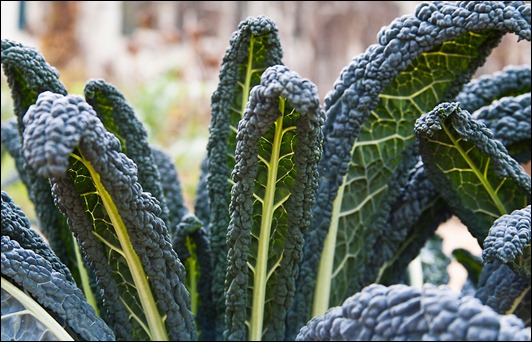We are reaching the end of the winter (hopefully), and the only vegetable that still survives on our sad orto (vegetable garden), all covered in snow, is il cavolo nero toscano (Tuscan black cabbage). With its tufts of long, dark green leaves that look almost black against the white wintery mantle, il cavolo nero is very commonly cultivated in Toscana and used in a variety of winter recipes. Planted at the beginning of the summer, it’s best eaten after the first frosts of late autumn/early winter, when the leaves are more sweet and tender.

Here is a traditional recipe from the Garfagnana area near Lucca:
Minestra di Farro e Cavolo Nero (Black Cabbage and Spelt Soup):
| Ingredienti |
Ingredients |
Fagioli borlotti secchi gr 200
farro gr 150
pancetta gr 50 (optional)
un cavolo nero
una cipolla
una carota
un gambo di sedano
6 cl di passata
olio extravergine d’oliva
sale e pepe |
Dried borlotti beans 200 grams
spelt 150 grams
bacon 50 grams (optional)
one black cabbage
one onion
one carrot
one stalk of celery
60 ml of tomato passata
extra virgin olive oil
salt and pepper |
Preparation:
Soak the beans for twelve hours minimum, then rinse and cook them in plenty of cold water. When the beans are cooked, sieve half of them and put them back into the saucepan. Bring it back to boiling point, then add the spelt and let it cook for about an hour.
Meanwhile chop the bacon in small cubes, finely slice the onion, the celery, the carrot, and the black cabbage.
Put 5 tablespoons of olive oil in a saucepan, add the bacon, onion, carrot and celery and sauté. When the onion is soft, add the passata and the cabbage, salt and pepper, and leave to cook for a few more minutes. Then pour this soffritto into the saucepan with the beans and spelt. Cook for another 20 minutes.
Leave the soup to cool down a little. Serve it con un filo d’olio e un pizzico di pepe (with a drizzle of oil and a pinch of pepper).
Siete Vegetariani?
If you’re vegetarian this minestra is equally as tasty without the pancetta. In fact that’s how we eat it!
P.S. The title of this blog ha un doppio senso (has a double meaning): 1. What cabbage are we eating today? 2. What the f**k are we eating today? Cavolo is a euphemism for cazzo






Comments:
david:
salve!
vorrei solo menzionare che benché la pancetta venga sempre tradotta in’bacon’per noi americani o altri di lingua inglese mentre prosciutto per esempio no, la pancetta si può trovare negli stati uniti con la stessa facilità con la quale si trova il prosciutto. e non credo che il bacon sia uguale alla pancetta sbaglio?
ormai perfino pancetta è diventata una cosa abbastanza commune… ma forse mi sbaglio… la cosa può essere ben diversa in north dakota per esempio!:)comunque grazie per il blog!
mi aiuta tantisssimo con la lingua!
david